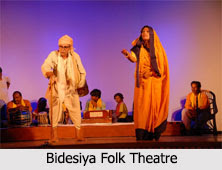Manjusha Art, Bhagalpur (Bihar)
An old tale of how a loving and devoted wife fights against all odds for her dead husband and brings him back to life has been told through generations in various forms - Savitri and Satyavan from Madra region, Bihula and Bala Lakhendra from Anga region etc. Although the essence of tale remains the same but the folk tales differ in narrative.
The origin of name of the art has an interesting story. “Manjusha” means a boat. Upon request from Bihula, a boat with cover was made to carry the dead body of Bala Lakhendra. The cover was painted with all the events leading upto his death in a sequential manner. Since then, during the Bishahari Puja, a temple shaped box with eight faces is made depicting the story of Bihula - Bishari. The festival is celebrated in the month of August.
The origin of name of the art has an interesting story. “Manjusha” means a boat. Upon request from Bihula, a boat with cover was made to carry the dead body of Bala Lakhendra. The cover was painted with all the events leading upto his death in a sequential manner. Since then, during the Bishahari Puja, a temple shaped box with eight faces is made depicting the story of Bihula - Bishari. The festival is celebrated in the month of August.
According to the legends, Mansa Devi (also known as Maya bishahari) is one of the “Manasaputri” (adopted child) of Lord Shiva. She is believed to have been originated from Lord Shiva’s hair. She was born along with 4 sisters. Together, these 5 sisters were known as “Bishahari” - means person carrying poison. They wanted to be worshipped and approached Lord Shiva’s devotee Chandu Saudagar. The devotee refused to worship anyone else other than Lord Shiva. In a fit of anger, Bishaharis killed all his sons with the snakes and drowned all his ships worth fortunes.
After few days, a son was born again to Chandu Saudagar’s house. Bishaharis came and cursed the devotee that if he won’t worship them, she would kill his son on his bridal night. When the child, Bala Lakhendra, reached his marriageable age, Chandu saudagar found a girl of intelligence and persistent to be his daughter-in-law, Bihula. He also built a house with no windows or holes for snakes to enter and kill his son. However, the son died due to snake bite on his wedding night. Bihula accompanied her husband’s dead body in “Manjusha” (a boat) to Inderlok to get back her husband’s life. During this process, she encountered a lot of problems but never gave up. In the end, the Bishaharis took pity on her and returned her husband. Since then, every August a festival is organised to honour the five sisters ”Bishaharis”. Temples were built for them and they were worshipped as Gods.
Manjusha Art is a heritage of Ang Pradesh (present times Bhagalpur in Bihar district). According to Prof. D.N. Ray of Tilka Manjhi University, Bhagalpur “The Bishahri worship can be traced back to the Indus Valley Civilization. The Sarpa Kalas at Bisharithaan is similar to the Sarpa Kalas found in the excavation of Lothal. Bishari puja has originated at this time when Nag Cult migrated into the Shiv Cult.” The door frame at Bishahari temple dates back to 6-7th century AD.
Manjusha art is believed to be the only art form in the history of India which has a sequential representation of the story and is displayed in a series pictorially. This is also called a scroll painting.
The art was re-discovered by W.G Archer during his visit to India in 1934 - 1942. He was so impressed and fascinated with this art that he held an exhibition in India House, London to showcase the paintings. The art is prominently practiced by Malakar & Kumbhkar Castes in present day Bihar.
Manjusha was originally a scroll painting drawn on the box during the Bishahari puja. With the effort of Mr W.G Archer, the art was transferred on handmade paper to reach wider audience. In 1985, local artists and Bihar government came together to promote this art. A large contribution was made by Mr Manoj Pandit, awarded with Shilp Guru for this art.With his continuous efforts the art has now made progress beyond paintings. The art now finds its way on various other home decor products, garments etc for greater reach.







Comments
Post a Comment